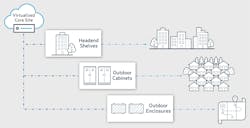Winning Broadband Subscribers With Service Reliability
How to Increase the Availability of High-Speed Internet, Add Subscribers and Sustain Long-Term Success With Virtualization
The battleground for broadband competition has shifted. With wireless providers offering packages that claim 85 Mbps downloads for just $45 a month, price is certainly critical, but most households factor another aspect into selection of their internet provider: quality of experience.
Consumers recognize that fixed-line broadband delivers a more resilient, reliable high-speed connection. When deployed with the right technology behind the scenes, both fiber-to-the-home (FTTH) and cable broadband can be commercially compelling, value-differentiated options for users.
Reliable, Economically Sustainable Broadband is Key
More than 100 operators globally recognize that a virtualized broadband network core provides simplified footprint expansion, improved quality of experience, flexibility to adapt to new technologies rapidly, and a disruptive cost structure to enable competition at any price point.
It shouldn’t be a surprise. Moving compute-heavy tasks from historically expensive, monolithic devices at the edge of the network to standard multipurpose cloud infrastructure reduces equipment cost. Virtualized cores run on enterprise CPUs that follow Moore’s Law, constantly improving and reducing the cost per bit processed. The industry’s leading cloud-native platforms support in-service upgrades so the benefit of new processors can be captured without disruption to edge devices.
A virtualized core accelerates time to market for new features. Software development is not constrained by hardware limitations, as it is possible to scale the cloud to unforeseen workloads and provides flexibility to accommodate a broader capability.
Capital cost isn’t the only area commercially disrupted by virtualization. Handling core operations on a cloud infrastructure naturally lends itself to automated configuration, network intelligence, and more efficient ecosystem monitoring.
Advanced software tools help reduce recurring costs associated with deploying and running a network. Adopting a solution with automated zero-touch provisioning of edge devices through the core reduces technician time in the field and, more importantly, mitigates the probability of configuration error that might negatively impact service later.
Similarly, streaming telemetry provides operators with access to real-time data collection and machine-learning engines to translate raw metrics into actionable recommendations. In emergency response scenarios, a holistic view into the system helps operators pinpoint errant activity and allows more informed, prioritized triage, resulting in responsive actions that have higher probability of success and broader impact. As operators improve uptime, they are able to shift focus to proactive network maintenance to address issues before customers are impacted. Truck rolls are reduced and, when required, have a higher first-trip success rate.
Plan Ahead, Even if the Future is Unclear
Cloud compute is not tied to any single technology. Even today, operators deploy virtualized cores to enable broadband across both fiber and coax. As new technologies emerge, a cloud-native infrastructure and virtualized core is readily positioned to support forthcoming standards while retaining a single pane of glass for network configuration, management, and monitoring.
Multipurpose virtualized cores protect an operator’s investment. Consider operators that primarily offer DOCSIS-based broadband services and are gradually adding FTTH-based broadband. A virtualized core allows both services to coexist and as demand shifts, compute resources can be reallocated without stranding cloud equipment.
Similarly, a virtualized core accelerates time to market for new features. Software development is not constrained by hardware limitations, as it is possible to scale the cloud to unforeseen workloads and provides flexibility to accommodate a broader capability.
This concept is being realized in the context of the recently announced BoostD 3.1, which is enabling operators using any of Harmonic’s 150,000 deployed DOCSIS 3.1 RPDs to offer 8-plus Gbps download speeds through a software-only configuration. Similarly, FTTH is being unlocked with OpenONU support to permit third-party, in-home devices. As Wi-Fi 7 gateways enter the market and new or cost-reduced ONU/ONT become available, broadband providers are empowered to select the vendor or model that best suits their broadband offerings.
Do More With Less Real Estate
Virtualized cores deliver incredible reductions in data center space and power consumption. Overall, Harmonic’s cOS® Broadband Platform deployments have saved an estimated 19,000-plus racks and reduced operators’ energy bills by over $100 million annually. In many instances, it has enabled consolidation of 28 racks into one single standard rack. While incredible, the virtualized core provides another more important advantage relative to real estate.
Acquiring a property for telecommunication equipment is incredibly expensive, time consuming, and complex. A virtualized core, coupled with a versatile portfolio of edge devices with a single pane of glass for operations, provides flexibility to deploy anywhere.
Handling core operations on a cloud infrastructure naturally lends itself to automated configuration, network intelligence, and more efficient ecosystem monitoring.
If a cabinet isn’t available, pivot to another option. Certain node enclosures are designed to be hidden in an underground vault, pedestal, or can also be strand mounted on telephone posts. This type of edge device can include remote switch modules, enabling an operator network to traverse thousands of kilometers from brick-and-mortar facilities. Simultaneously, these enclosures can house Remote Optical Line Terminals (R-OLT) for 10G FTTH, and Remote PHY Devices for DOCSIS (RPD), alleviating requirements for a cabinet and often simplifying permit processes. There are also wall-mounted clamshell options that can discretely be deployed in regions sensitive to visual obstructions. Moreover, some of these enclosures can also be placed inside, leveraging a switchable AC power supply.
Regardless of the location, operators should consider adopting the latest generation of OLT’s and OLT optics. High-power OLT optics extend the reach of last-mile optical distribution networks, effectively expanding the serviceable market by moving the edge outward from existing points of presence. Additionally, current generation products handle a wider range of network conditions providing a more resilient communication between the subscriber ONU/ONT and operator OLT. The result is an investment justified by opportunities to cost effectively secure new customers and reduction of churn within the existing subscriber base.
About the Author
Dan Gledhill
Senior Vice President, Broadband Business Operations, Harmonic
Dan Gledhill is Senior Vice President, Broadband Business Operations at Harmonic. With over a decade of experience in sales, operations, and technical leadership positions, Dan has helped operators worldwide launch and enhance their broadband services while optimizing network infrastructure. For more information, please email [email protected] or visit www.harmonicinc.com/broadband/. Follow them on LinkedIn, Facebook, and Twitter.

